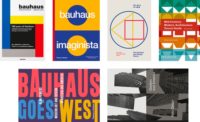The Spirit of the Bauhaus, translated from the French catalogue L’Esprit du Bauhaus, by Ruth Sharman; edited by Olivier Gabet and Anne Monier. Thames & Hudson, 188 pages, $50.
This fine new English translation of the French catalogue for the Bauhaus show at the Musée des Arts Decoratifs in Paris, in 2016, is a worthy addition to the scholarship on the legendary school as it celebrates its 100th anniversary.
The tenure of the Bauhaus was famously short, from 1919 to 1933. This book provides a definitive retrospective of its accomplishments, with 24 provocative essays by director Olivier Gabet and six curators of the Musée des Arts Decoratifs, as well as scholars Jean-Louis Gaillemin and Nicholas Fox Weber.
The focus is the inner workings of the school as it morphed under each director— Walter Gropius (1919–28), Hannes Meyer (1928–30), and Ludwig Mies van der Rohe (1930–33). The Bauhaus was an evolving, avantgarde, utopian experiment in Modernism, whose instructors included Gropius, Mies, Josef and Anni Albers, Marcel Breuer, Herbert Bayer, Paul Klee, and Wassily Kandinsky.
Half the essays focus on individual workshops, including painting, architecture, sculpture, ceramics, stained glass, cabinetmaking, metalworking, mural painting, photography, bookbinding, and theater.
A few essays cite the teachers’ various ideological roots. In his Bauhaus manifesto, Gropius urged “architects, painters, and sculptors to return to traditional crafts as a source of regeneration. Together let us desire, conceive, and create the new structure of the future.”
Klee and Alma Mahler had a passion for Theosophy and Rudolf Steiner’s writings. Kandinsky was interested in astrology, alchemy, and “the spiritual in art.” Johannes Itten followed Otoman Zur-Adusht Hanish, founder of the Mazdaznan faith (which combined elements of Christianity, Zoroastrianism, and Tantrism). Some members of the Bauhaus were Socialist, others Communist.
The book reads as if it were a contemporaneous account, complete with photos of the participants, their jubilant activities, and workshop output. It’s a perfect companion to Barry Bergdoll and Leah Dickerman’s excellent catalogue for the 2009 MoMA exhibition, Bauhaus: 1919–1933: Workshops for Modernity.
Bauhaus Journal 1926–1931, facsimile edition. Lars Müller Publishers, 428 pages, $80.
A key primary source for scholars, this is the first publication of the Bauhaus journals in English and in a font large enough to read easily, unlike the originals. From 1926 to 1931, the school produced 14 issues—really six-page newspapers—for some 3,000 subscribers. The idea was to disseminate the Bauhaus’s artistic and social ideas with news, illustrated articles, and photographs of art and objects produced in the workshops. Each issue had a different editor and thrust. While László Moholy- Nagy devoted his to typography, Gropius focused on product standardization, and Oskar Schlemmer on his innovative designs for theater.
Publisher Lars Müller and the director of Berlin’s Bauhaus-Archiv/Museum für Gestaltung, Annemarie Jaeggi, have written short essays on how crucial it was that a small school reached a wide audience across Europe.
Bauhausbücher 1, 2, 5, and 8. Lars Müller Publishers, $45; $34 paper.
Müller has also published handsome facsimiles, without commentary, of four slim, Bauhausproduced volumes from the 1920s. International Architecture, edited by Gropius, is a book of photos of modern buildings, models, and designs by him and his Modernist contemporaries, including Frank Lloyd Wright, Mies, Adolf Loos, Bruno Taut, and Peter Behrens. Moholy-Nagy’s Painting, Photography, Film is a defense of photography as an art form, illustrated by manipulated photographs. Klee’s Pedagogical Sketchbook reproduces the drawing lessons of his Bauhaus instruction plan. And in New Design: Neoplasticism, Piet Mondrian shares his (incomprehensible) theories on “new painting” and its relationship to the unconscious, music, architecture, and dance.







Post a comment to this article
Report Abusive Comment